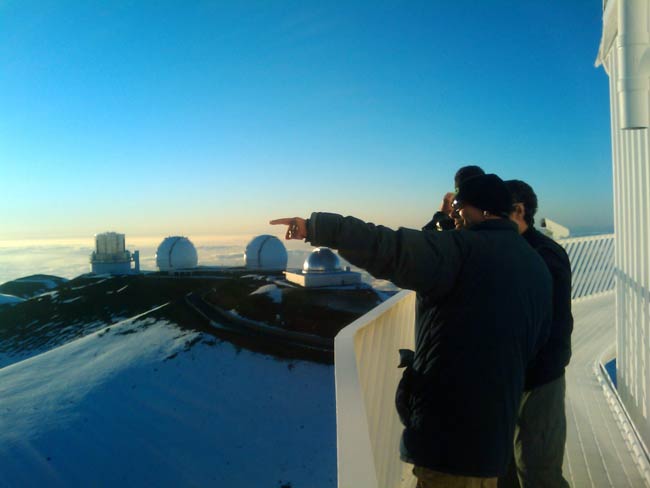On Top of the World With the SETI Institute

Each year, Mail Archive colleagues Jeff Breidenbach and JeffMarshall take time from their busy schedules to seek out a few causes worthy ofsupport. Throughout the years, the team has followed the business practicepioneered by Ben & Jerry?s, which includes donating a fixed percentage ofpre-tax income to a good cause. Given the uncertain economy, it?s laudable thatsmall business owners would choose to support a charitable organization.
Familiar with the SETI Institute, the colleagues perused theInstitute?s website, and the Adopt aScientist program captured their attention. After reading through the listof fascinating scientists participating in the program, Jeff Breidenbach choseto ?adopt? Dr. Franck Marchis.? Jeff?s personal interests are in perfectalignment with Marchis? work, and he says, ?Franck had the coolest project!?
According to Jeff, ?Adaptive optics sounded like great fun.Franck gets to play with lasers and motors and electronics and signalprocessing, and in the end -- hopefully -- sees things nobody else in the worldhas ever seen. The scale of astronomy blows me away. Franck explained to me thatit is common to make an observation, and then wait half a year so that theearth is in a different location and measure again to see things from aslightly different orientation. He thinks about and works with these things ona daily basis. What's the grandest thing you thought about today? For me, itwas probably pondering the weather.?
Jeff jokes that theprogram made him feel like a patron from the Middle Ages supporting aclassical composer, ?which was fun!? He adds, ?I'm glad we live in a world withhopes and dreams; and in that respect, the SETI Institute is one of the mostinspiring organizations in the world.?
Jeff and a guest joined Franck on a spectacular expedition,which involved a personal tour of the CFHT (Canada-France-Hawaii Telescope) Observatory,which is situated atop the dormant MaunaKea volcano that rises 4,200 meters above the Pacific Ocean on the islandof Hawaii. It was a rare opportunity not available to the general public. Theexpedition created several life-long memories for Jeff. He and his guest weretreated to what must rank among the most spectacular views in the world. Amidsta freezing 40-knot wind on the observatory?s catwalk, they savored amagnificent sunset as the snowy mountaintops cast a shadow onto the atmosphereabove the clouds.?
Another highlight of the expedition was the time spent withFranck and his colleague and ?resident astronomer,? Olivier Lai. Jeffparticularly enjoyed learning about Olivier's in-progress giant interferometerproject called O?HANA, which means ?family? in Hawaiian and will eventually gatherand combine light from all seven observatories on Mauna Kea. Jeff says he madeholograms in college and people had to hold their breath for nearly 30 secondsso no vibrations disturbed the light. He adds, ?Everything has to be stable --ideally to well under a quarter wavelength of light. Olivier?s system hasrequirements, but there are moving motors involved. And not little submicronmovements; we're talking multiple feet over a 30-minute exposure! I was blownaway by the sheer audacity. How could one even think to try such a thing? Andthis multi-year, cutting edge project is in progress, right there in front ofme, with this very scientist. It felt like stepping into another very excitingworld.?
Out of curiosity, Jeff asked Olivier what percentage ofprojects totally fail, guessing the answer would be at least half. ?Apparentlyastronomers build lots of utterly crazy instruments, and most of them actuallywork. Astounding!?
Breaking space news, the latest updates on rocket launches, skywatching events and more!
Jeff had previously imagined the Institute as a giantroulette game in which ?you do a ton of work and it either boils down tohearing a signal or not; with maybe some spin-off technology developments.? Buthe notes, ?That is simply not true! I was so impressed by Franck?s depth ofknowledge,? he says. ?I?m very impressed by the substance that is behind thescientists. This is clearly not a bunch of people working on PowerPoint slidesall day ? these are real people doing really meaty work and that was veryheartening to see. I?m very appreciative of the experience.?
Jeff?s impression of the Institute and the Adopt a Scientistprogram has been very positive. ?A lot of places we donate to act like a blackhole; you don't hear anything back and hopefully the money goes to somethinguseful,? says Jeff. ?As far as I'm concerned that's fine, assuming the moneyactually does go to something useful. The SETI Institute, however, goes out of itsway to engage supporters. I'm supremely appreciative, honored, and enriched bymy interaction with Franck and I can't thank him enough for generously sharingsome of his time. I'm very proud and happy to help support such work.?
Franck is honored to have been adopted by Jeff through theSETI program. Franck enjoyed the opportunity to share with Jeff the excitementof his new projects but also to show him the human side of his work. Franck isconvinced that the interest and support of the public is mandatory to lead tosuccessful projects. After Jeff?s visit, Franck and Olivier had insightfuldiscussions about interferometry and its application to science. As a result,Olivier and Franck will initiate a collaborative work involving a new idea foran instrument project.
The SETI Institute gratefully acknowledges the MailArchive?s support of its Adopt a Scientist program. There are many levels ofsupport available, beginning at $1,000, with expeditions, such as the onedescribed above, available at higher levels. To learn more, visit the Adopt a Scientist webpage.?
